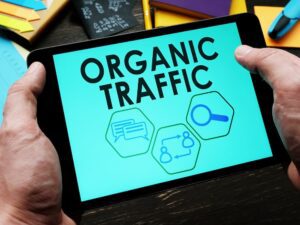
How to Improve Your Organic CTR

As we’ve mentioned before SEO is more than ranking well on Google and there are now various SERP features that can impact your CTR or even display the user’s query result within the SERP itself.
This often means that users no longer need to even click on the search results to find your content.
Over the last few years, this has highlighted new obstacles for SEOs, across a range of industries, as we’re seeing our CTR being impacted drastically. Although this is the case, at Embryo, we understand that Google is continuing to evolve and learn from user behaviour, so we continue to adapt our way of thinking to help improve organic CTR.
What is Organic CTR?
Organic click-through rate (CTR) is a ratio showing how often people who see your organic search listing end up clicking it. This can be used to gauge how well your target search terms and SERP results are performing.

Analysing Your Current CTR Performance
Before looking into how we can improve click-through rate, it’s crucial to ask yourself ‘Is this the page that should be ranking for this query?’.
Utilise Keywords
We would always recommend completing a keyword mapping exercise to understand the different types of user intent at all stages of the buying journey and mapping this alongside your content.
For example, if a user asks a long-tail query such as a “what is” question about your product or service, you may want to drive them to an educational guide to answer their query rather than leading them to a product page.
On the other hand, if we’re trying to drive traffic to specific product pages, we’d be looking to drive traffic through transactional queries using terms like “sale”, “buy”, “cheap” etc as these would have a higher chance of converting.
Avoid Keyword Cannilablisation
If you’re optimising content for keywords you need to ensure that multiple pages are not targeting the same keywords. This is because search engines find it difficult to determine which pages have more value and this can actually cause pages to rank lower on the SERPs. This in turn harms CTRs as lower rankings can reduce the chance of clicks.
Use Google Tools
It’s often difficult to determine what a good organic CTR is as each SERP is completely different in its own way. Whether you’re optimising for a long tail query to achieve a featured snippet or you’re searching for highly competitive, product queries and shopping ads are present; CTR can vary drastically.
Due to this, we would always recommend starting with your Google Search Console and Google Analytics data.
You can use both conversion data within GA and search volume to prioritise your top landing pages, then sift through the queries driving the traffic to ensure these are relevant to the page. If your click-through rate is then lower than expected (using your other pages and competitors as a benchmark) these are the pages we can focus on first, using some of the techniques below.

Testing Page Titles & Meta Descriptions
Many SEOs often ‘optimise’ their page titles and meta descriptions at the start of a campaign and never really revisit them. But is this really optimising them?
We often define ‘optimisation’ as a process, or methodology of making something as effective as possible.
So if your page title isn’t encouraging the best possible CTR it can, it’s not fully optimised. Optimising for search engines is one thing, but optimising for your users is another.
There are a range of different techniques which can be used for optimising your page titles and meta descriptions, in order to improve your click-through rate.
- Include your target keywords – this not only helps the crawler understand your page, but also shows the user that you’re delivering the content they’re looking for,
- Keep it short and snappy. Make sure the user knows that you’re going to solve the problem they’re searching for,
- Use numbers and brackets in title tags as this can make them more appealing,
- Include core USP’s or offerings your user is particularly interested in; such as ‘Open 24 hours a day’ or ‘Free Next Day Delivery’,
- Apply title case across all page titles, as this is proven to help increase CTR for both paid ads and organic search listings too,
- If your content is time-sensitive and relevant, include the year (or date) when you produced the content, this will show readers that your information is up to date.
Completing all of the above (or even the majority) doesn’t mean you will instantly increase your organic click-through rate. This is why you should consistently test which works best for you and your brand. You can monitor all progress, by landing page directly within Google Search Console.
Please note: When optimising these on-page elements, you should always ensure you are avoiding clickbait.
It can often be tempting to create a ‘catchy headline’ or use these in your meta descriptions; although this will inevitably create a higher bounce rate on site. Bounce rate is not known to be a direct ranking factor, yet many believe that this can actively impact rankings over a period of time; as Google will understand that you’re not delivering the content which your user is looking for.
Using Structured Data
Implementing schema markup, also known as structured data, on your pages can also be a great method to stand out from your competitors on the SERPs, and encourage users to click on your organic result rather than theirs.
To date, there are over 700 different variations of schema markup which can be implemented on your pages; with the vast majority of which can help increase your organic CTR.
Essentially, by using structured data on your landing pages, you’re giving Google additional information about your content, so it can deliver rich search results within the SERP. Here are just a few examples which you could use:
Product Schema Markup
Perfect for any product, product schema markup can enable a range of various details to be pulled into the SERPs. For example; price, colour, dimensions, aggregate rating, stock levels and many more.
There’s also the ability, with e-commerce stores, to add in ‘offer markup’ too; whereby offers will also pull into the search engine results.
SoftwareApplication Markup
Ideal for apps; you can include aggregate star rating reviews, pricing, device compatibility, latest update date and even the number of installs.
Recipe Schema Markup
This structured data is ideal for any recipe page; where click-through rate can be encouraged by marking up everything from reviews, prep time and cook time, to nutritional values and recipe ingredients.
Event Schema Markup
Using event markup enables users to see upcoming events at specific venues or from ticket merchants. This type of markup also allows users to directly click through to specific events, which in turn, can increase your organic CTR.

Optimise for Featured Snippets
Over the past few years, the rise of featured snippets within SERP results has been on the horizon; and you’ll have noticed these results as a user. These results boxes are a great opportunity to showcase a small snippet of information which the user is looking for; encouraging them to click through to your site.
When you search, you often no longer need to click to find the result you’re looking for. That being said, HubSpot conducted a study which found that CTR for their high-volume keywords increased by over 114% when the results appeared as featured snippets.
Take Advantage of ALL Marketing Channels
Finally, your marketing channels really can be your best asset when it comes to increasing CTR.
Whether you currently run paid search advertising, organic or paid social, or have regular CRM communications with your customers and prospects. This is really valuable data to cross-reference throughout your campaign.
- Are your email subscribers interested in a certain form of content?
- Do you find you have a better open rate with specific headlines?
- Do you regularly test your PPC ad copy?
- Do your users respond better with certain CTA’s within your copy?
- All of this data is extremely valuable.
Just as your organic performance data can be for those channels too.
Those interested in your brand will have certain characteristics which you may be able to utilise across all channels; so it’s often worth taking a look and continuing to test this, to see what works best for you and your brand.
If you’re interested in finding out more about increasing your organic performance or how your marketing channels may be able to work better together, get in touch with our team today.



